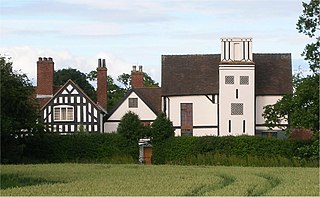
Boscobel House is a Grade II* listed building in the parish of Boscobel in []. It has been, at various times, a farmhouse, a hunting lodge, and a holiday home; but it is most famous for its role in the escape of Charles II after the Battle of Worcester in 1651. Today it is managed by English Heritage.

Great Chalfield Manor is an English country house at Great Chalfield, about 2.5 miles (4 km) northeast of the town of Bradford on Avon in the west of the county of Wiltshire.

Little Moreton Hall, also known as Old Moreton Hall, is a moated half-timbered manor house 4.5 miles (7.2 km) southwest of Congleton in Cheshire, England. The earliest parts of the house were built for the prosperous Cheshire landowner William Moreton in about 1504–08, and the remainder was constructed in stages by successive generations of the family until about 1610. The building is highly irregular, with three asymmetrical ranges forming a small, rectangular cobbled courtyard. A National Trust guidebook describes Little Moreton Hall as being "lifted straight from a fairy story, a gingerbread house". The house's top-heavy appearance, "like a stranded Noah's Ark", is due to the Long Gallery that runs the length of the south range's upper floor.

Aston Eyre is a hamlet and civil parish in Shropshire, England, about four miles west of Bridgnorth. The area has a significant amount of green space. The spine road that runs through the centre of the village is the B4368.

Chenies Palace in the parish of Chenies in Buckinghamshire, England, is a Tudor Grade I listed building once known as Chenies Manor House, although it was never a royal seat nor the seat of a bishop. It was held by the Cheney family since 1180 and passed by marriage successively to the Semark and Sapcote families and thence in 1526 to the Russell family, Earls of Bedford, later Dukes of Bedford, by whom it was held for several centuries. Although the Russells soon abandoned Chenies as its main seat in favour of Woburn Abbey in Bedfordshire, Chenies parish church remains the site of the private "Bedford Chapel", the mausoleum still in use by that family.

Moreton Corbet is a village in the civil parish of Moreton Corbet and Lee Brockhurst in Shropshire, England. The village's toponym refers to the Corbet baronets, the local landowners.

Combermere Abbey is a former monastery, later a country house, near Burleydam, between Nantwich and Whitchurch in Cheshire, England, near the border with Shropshire. Initially Savigniac and later Cistercian, the abbey was founded in the 1130s by Hugh Malbank, Baron of Nantwich, and was also associated with Ranulf de Gernons, Earl of Chester. The abbey initially flourished, but by 1275 was sufficiently deeply in debt to be removed from the abbot's management. From that date until its dissolution in 1538, it was frequently in royal custody, and acquired a reputation for poor discipline and violent disputes with both lay people and other abbeys. It was the third largest monastic establishment in Cheshire, based on net income in 1535.
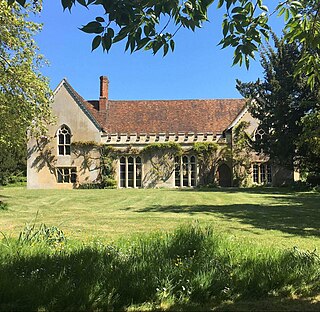
The Abbey in Sutton Courtenay is a medieval courtyard house in the English county of Oxfordshire. It is located in the Vale of White Horse near the River Thames, across the road from the twelfth-century Norman Hall and the Manor House. The Abbey has been recognised as a building of outstanding historic and architectural interest and is considered to be a ‘textbook’ example of an English medieval manor house. It has been a Grade I-listed building since 1952.

Burneside is a small village in South Lakeland in Cumbria, England. It is located to the north of Kendal and to the south east of Staveley, on the River Kent, just upstream from the confluence of the River Sprint. It has about 3,000 inhabitants. By the time of the 2011 Census Burneside had been transformed into an electoral ward only. The population of this ward was 1,888. The majority of the population are now recorded as living in Strickland Ketel parish.

Peckforton is a scattered settlement and civil parish in the unitary authority of Cheshire East and the ceremonial county of Cheshire, England. The settlement is located 6.5 miles (10.5 km) to the north east of Malpas and 7.5 miles (12.1 km) to the west of Nantwich. The civil parish covers 1,754 acres (710 ha), with an estimated total population of 150 in 2006. The area is predominantly agricultural. Nearby villages include Bulkeley to the south, Beeston to the north, Higher Burwardsley to the west, Spurstow to the east and Bunbury to the north east.
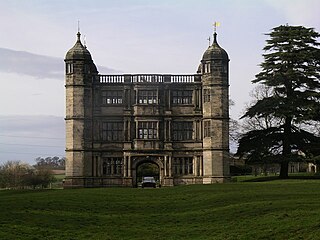
Tixall Gatehouse is a 16th-century gatehouse situated at Tixall, near Stafford, Staffordshire and is all that remains of Tixall Hall which was demolished in 1927. The gatehouse is a Grade I listed building. Tixall was used as a prison for Mary, Queen of Scots for two weeks in 1586.
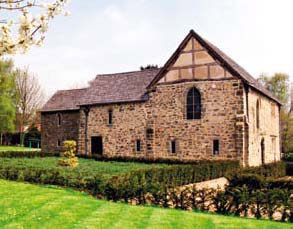
Donington le Heath Manor House Museum, now 'The 1620s House and Garden at Donington le Heath' is a surviving example of a manor house built over seven hundred years ago in Donington le Heath, near the town of Coalville, Leicestershire. It was once owned by a relative of one of the Gunpowder plotters, and is now managed by Leicestershire County Council.
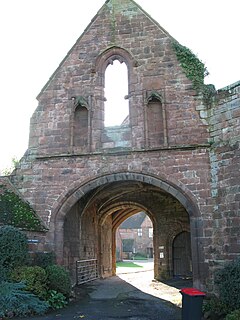
Maxstoke Priory was an Augustinian priory in Warwickshire, England. The substantial remains are on Historic England's Heritage at Risk Register due to their poor condition.

Damhouse or Astley Hall is a Grade II* Listed building in Astley, Greater Manchester, England. It has served as a manor house, sanatorium, and, since restoration in 2000, houses offices, a clinic, nursery and tearooms.
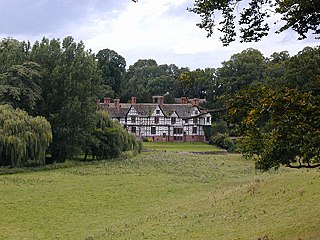
Pitchford Hall is a large Grade I listed Tudor country house in the village of Pitchford, Shropshire, 6 miles south east of Shrewsbury.

The hall house is a type of vernacular house traditional in many parts of England, Wales, Ireland and lowland Scotland, as well as northern Europe, during the Middle Ages, centring on a hall. Usually timber-framed, some high status examples were built in stone.
Mudford Manor is a historic 17th century Jacobean manor house situated on the Dorset/Somerset border in Mudford, Yeovil. The estate is surrounded by wild meadows with far-reaching views over the River Yeo to the village of Trent in Dorset. The Mudford Manor house is a six-bed freehold detached house situated and is one of two properties situated on the Mudford Manor Estate along with Mudford Manor Barn.

Upton Cressett is a village and civil parish in the English county of Shropshire. Population details for the 2011 census are shown under Aston Eyre parish.

Upton Cressett Hall is an Elizabethan moated manor house in the village of Upton Cressett, Shropshire, England. It is a Grade I-listed building.

Madeley Court is a 16th-century country house in Madeley, Shropshire, England which was originally built as a grange to the medieval Wenlock Priory. It has since been restored as a hotel.
J. Newman & Sir N. Pevsner, The buildings of England: Shropshire, 2nd edn., 2006, pp. 122–123 M. Wood, The English medieval house, 1965, pp. 77–8, 104, 110, 132, 133 (plan), 334




















